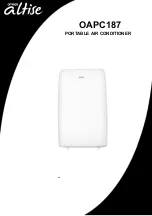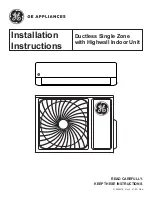
38
Single Zone
Art Cool Premier W
all Mounted Installation Manual
Due to our policy of continuous product innovation, some specifications may change without notification.
©LG Electronics U.S.A., Inc., Englewood Cliffs, NJ. All rights reserved. “LG” is a registered trademark of LG Corp.
REFRIGERANT PIPING CONNECTIONS
1. Typical location (Air-conditioned location): When the piping passes through an indoor area where the indoor unit operates.
• Apartment, classroom, office, mall, hospital, etc.
2. Special location (Air-conditioned location):
1. When the location is air conditioned, but there is severe temperature/humidity difference due to high ceilings.
• Church, auditorium, theater, lobby, etc.
2. When the location is air conditioned, but internal temperature/humidity are high.
• Bathroom, swimming pool, locker room, etc.
3. Typical location (Non-Air conditioned location): When the piping passes through an indoor area where the indoor unit
does not operate.
• Hallway or a dormitory or school, etc.
Minimum Refrigerant Pipe Ethylene Propylene Diene Methylene (EPDM) Insulation Wall Thickness Requirements
4. Special location (Non-Air conditioned location): If conditions 1 and 2 below are present.
1. When the piping passes through an indoor area where the indoor unit does not operate.
2. When the humidity is high and there is no air flow in the location where the piping is installed.
• The thickness of the above insulation material is based on heat conductivity of 0.61 Btu/in/h/ft
2
/°F.
Follow locals codes when selecting EPDM insulation wall thickness.
Classification
Air-conditioned location
Non-air conditioned location
1. Typical location
2. Special location
3. Typical location
4. Special location
Liquid pipe
ø1/4 inch
1/2 inch
1/2 inch
1/2 inch
1/2 inch
ø3/8 inch
≥ø1/2 inch
1/2 inch
1/2 inch
1/2 inch
1/2 inch
Vapor pipe
ø3/8 inch
1/2 inch
3/4 inch
3/4 inch
1 inch
ø1/2 inch
ø5/8 inch
ø3/4 inch
ø7/8 inch
ø1 inch
ø1-1/8 inches
3/4 inch
ø1-1/4 inches
1 inch
1 inch
ø1-3/8 inches
ø1-1/2 inches
ø1-3/4 inches
Table 16: Insulation Guidelines for Typical and Special Circumstances
Refrigerant Piping Insulation
















































